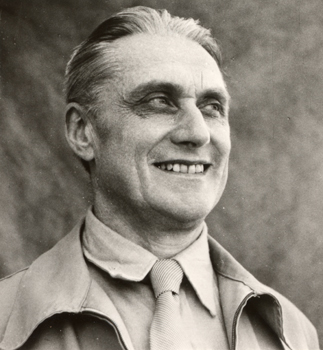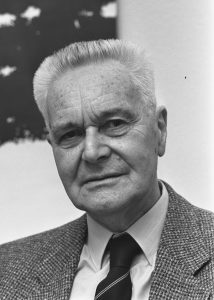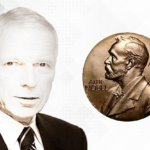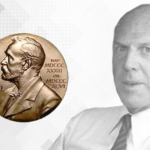It is not unusual for this important prize to be awarded to a duo, but in no other case was it awarded to two people whose careers overlapped as much as in the case of Ragnar Frisch and Jan Tinbergen, the first winners of the Nobel Prize in Economics in 1969 for their work on “the development and application of dynamic models to the analysis of economic processes”.
Ragnar Frisch was 8 years older than his colleague Jan Tinbergen, which is perhaps why he seemed to be a little ahead of Tinbergen throughout their careers. However, it was Jan Tinbergen who often developed the most prominent ideas. Indeed, their careers can be seen as somewhat parallel throughout history.
Ragnar Frisch

Born in Oslo on 3 March 1895, his family was linked to gold and silver activities (his father was a well-known goldsmith, Anton Frisch). The young Ragnar was supposed to continue the family business, and so he started as an apprentice to a famous Oslo goldsmith, David Andersen, with whom he remained until 1920 when he qualified as a craftsman. At the same time, thanks to his mother’s influence, he studied economics at the University of Oslo, graduating in 1919. A year later, he began his stays in France, Germany, the United Kingdom, the United States and Italy.
He then returned to Norway to become an assistant professor at the University of Oslo, where he defended his PhD degree in mathematical statistics in 1926. He was appointed to a specially created chair in 1931, where he stayed until his retirement in 1956. Ragnar Frisch is known as the pioneer of econometrics. In fact, he was one of the founding members of The Econometric Society in 1930. He was also the editor-in-chief of the journal Econometrica for 22 years (from 1933 to 1955).
He achieved great notoriety for articles on business cycles, possibly Frisch was the first to refer to the study of individual firms and industries as microeconomics and the aggregate economy’s study as macroeconomics. Unfortunately, because Ragnar Frisch was extremely meticulous (every article published by him had to be perfect before being published), many of his articles have not been published or published late. He was involved in various macroeconomic topics such as the business cycle, consumer behaviour, statistical theory and production theory, many of which are considered classics of economics.
Like other economists, Ragnar Frisch was interested in the problem of underdevelopment. He was an advisor to India and Egypt’s governments, and because of his frankness, he was expelled from the latter by President Nasser.
Ragnar died in Oslo in 1973, three years after his speech to the Royal Academy of Sciences on 17 June 1970; because of health problems, he could not be in Stockholm for the presentation of his prize in 1969.
Jan Tinbergen

Jan Tinbergen was born on 12 April 1903 in The Hague. This Dutch economist, known for his econometric models, was the brother of the renowned zoologist Nikolaas Tinbergen. He studied physics at the University of Leiden, where he obtained his doctorate in physics in 1920. After completing his studies, Tinbergen became interested in the mathematical formulation of economic phenomena. The focus of his research was on the problems of the minimum in both physics and economics.
After finishing his studies, Tinbergen joined the Central Statistical Office in The Hague, where he worked from 1929 to 1936 and from 1938 to 1945. From 1945 until 1955, he became director of the Central Planning Office, and his main concern was the quantitative analysis of his country’s economy. In 1933 he was an extraordinary professor at the Dutch School of Economics (now known as the Faculty of Economics at the Erasmus University of Rotterdam). Finally, he taught for two years at the University of Leiden before retiring in 1975.
Tinbergen analysed economic development in the United States of America from 1919 to 1932, a pioneering study in econometrics that provided a solid basis for his theory of the business cycle and guidelines for economic stabilisation. Between 1936 and 1938, he was a guest expert at the League of Nations in Geneva and was commissioned to carry out the second part of a project on business cycles, which was published in 1939 in two volumes. Jan constructed an econometric model that helped to shape economic and political planning in the Netherlands.
Tinbergen made his major contributions to applying data and statistical techniques to mathematical formulations of economic theory in econometrics. This is used for testing hypotheses of economic theory and the estimation of implicit relationships. He wrote on such important topics in economics as the mathematical analysis of the business cycle, the theory of economic growth, the theory of income distribution, the theory of economic development and the theory of measurement of elasticities.
Jan Tinbergen was recognised as a rigorous scientist and idealist whose work sought to reconcile economic efficiency and equity. He died on 9 June 1994 after a lifetime of uninterrupted work, so much so that his last published work was written in 1992 at the age of 89.
Convergence of the works of Ragnar Frisch and Jan Tinbergen
As mentioned above, Ragnar Frisch was the first to coin the term econometrics and one of the Econometric Society’s founders. Although Timbergen was not among the founders, he quickly followed him, for, at the first meeting of the Society in Lausanne in 1931, he let his PhD supervisor know that the soul of the conference had been Ragnar Frisch.
In the 1930s, Ragnar Frisch and Jan Tinbergen made contributions that proved to be fundamental to endogenous cycle theory. Tinbergen’s report to the League of Nations (his macro-econometric model of the United States) was designed in close collaboration with Frisch and his work.
Both headed important economic policy institutes. Later both men expanded their vision beyond their own continents and dealt with development planning issues in India and Egypt. One of the most relevant features is that both were believers in the prominence of economic expertise in the modern state.
Finally, in 1969 they were awarded the Alfred Nobel Memorial Prize in Economic Sciences, known as the Nobel Prize in Economics, to work on the business cycle. Had it not been for Ragnar Frisch’s broken femur that prevented him from attending the ceremony, it would have been the closing of a lifetime of confluence in the careers of Ragnar Frisch and Jan Tinbergen.








